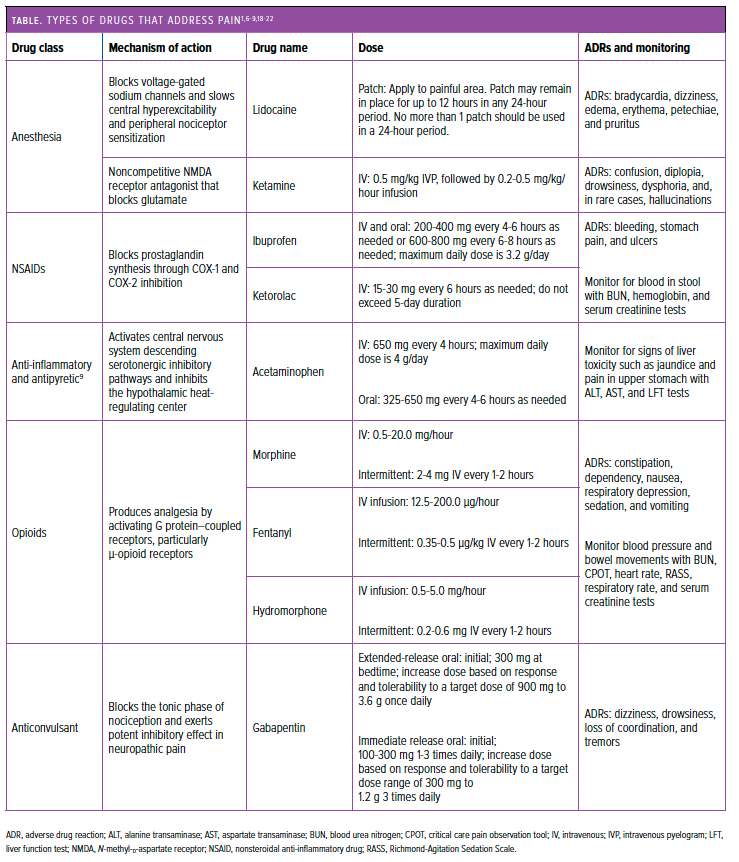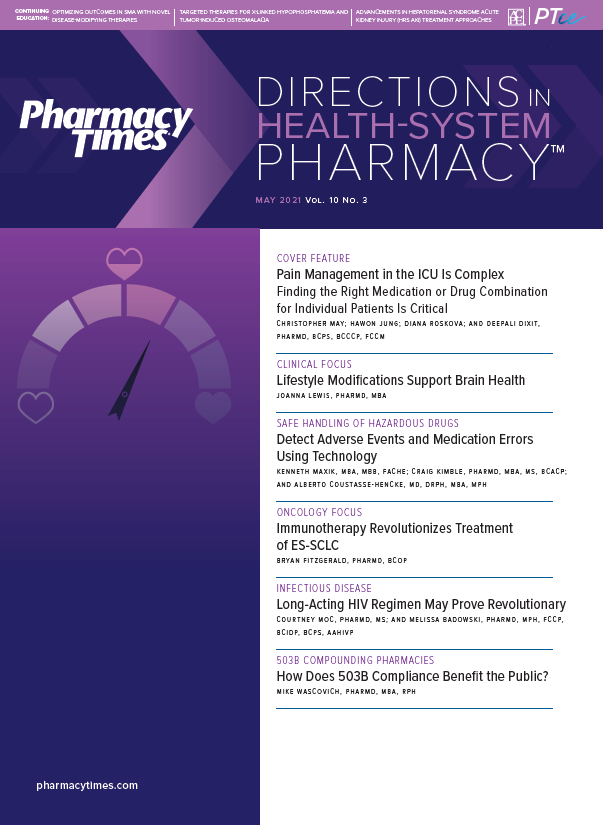Publication
Article
Pharmacy Practice in Focus: Health Systems
Pain Management in the ICU Is Complex
Author(s):
Finding the right medication or drug combination for individual patients is critical.
Pain management in the intensive care unit (ICU) is not a one-size-fits-all discipline. There are many factors to consider, including location and type of pain, breakthrough pain despite adequate management, and patient history of opioid use. But preventing pain instead of reacting to it is key.
It is important to keep in mind that pain management medications are not without the risks of oversedation and, ultimately, respiratory depression. Hence, it is imperative to find a balance in addressing pain by using medications that have different mechanisms of action.
The first class of medication that providers turn to is local anesthetics. Guidelines do not recommend the use of topical anesthetics in ICU patients. However, topical anesthetics can provide great advantages when other routes of administration are not plausible. Lidocaine is a local anesthetic that binds reversibly to sodium channels, blocking nerve depolarization by locking nerves in the open state.1 One study evaluated pretreatment with lidocaine 5% patches in acute potthoracotomy population pain. Results found that lidocaine was effective in reducing pain intensity and total morphine consumption. Therefore, lidocaine 5% patches could be considered as an adjunct treatment to intravenous (IV) morphine to control postthoracotomy pain.2 Nevertheless, the results of another study assessing the efficacy of topical lidocaine 5% patches in ICU patients in poststernotomy or postthoracotomy pain concluded that lidocaine did not reduce acute pain.3
Because of their low risk of systemic effects, minimal drug interactions, and safety profiles, lidocaine patches are considered a suitable treatment for the elderly population. However, variable skin properties in individuals may influence absorption and distribution. Additionally, many studies of topical medications lack quality; thus, further studies are needed to analyze effectiveness and long-term effects.4
The guidelines also suggest using low-dose ketamine for pain relief in post-operative adults in the ICU.5 Ketamine is a noncompetitive N-methyl-D-aspartate and glutamate receptor antagonist. It is recommended as an adjunct to opioid therapy to reduce opioid consumption in ICU patients with postsurgical pain. Common adverse effects (AEs) include confusion, diplopia, drowsiness, dysphoria, and, in some rare cases, hallucinations.6
Although opioids remain the mainstay of therapy in the ICU, the guidelines also recognize the negative effects that opioids pose and encourage the use of multi-modal therapies whenever possible to decrease opioid use.5 Two other classes of medications used in the ICU are nonsteroidal anti-inflammatory drugs (NSAIDs), and acetaminophen, an analgesic, and antipyretic medication. NSAIDs work by inhibiting prostaglandin synthesis through COX-1 and COX-2 inhibition.7 Patients must have stable renal functions and not be on concomitant nephrotoxic medications while receiving NSAIDs. These drugs should also be avoided in patients with gastric ulcers, active gastrointestinal (GI) bleeds, or a history of GI bleeds, and congestive heart failure.7,8 Additionally, in patients with severe cirrhosis or liver impairment, alternatives should be considered.9
Acetaminophen is the preferred initial agent of choice for ICU patients.5,10 According to the guidelines, IV, oral, or rectal acetaminophen should be used for pain control and to decrease opioid use in the critically ill population.5,10 Acetaminophen has proved to have comparable effects to opioids and demonstrated an opioid-sparing effect in multiple investigations. In 1 study looking at moderate to severe pain after orthopedic surgery, results showed that IV acetaminophen at a dose of 1 g, administered over 24 hours, reduced opioid need, and was well tolerated.11 The results of another study showed that the addition of acetaminophen to meperidine provided adequate pain control in patients and reduced their opioid need.12 Results from another trial demonstrated adequate pain control and opioid-sparing effects through the combined use of acetaminophen and tramadol in patients who have cardiac surgery.13
Similar opioid-sparing effects can be seen with NSAIDs, such as ibuprofen and ketorolac. Study results showed that using 800 mg of IV ibuprofen every 6 hours in patients who had postabdominal pain effectively controlled their pain and reduced their opioid requirements.14 The results of one controlled, randomized trial comparing IV morphine 4 mg with IV ketorolac 4 mg showed that pain scores were similar after chest tube removal. These results indicated that NSAIDs could be used as an alternative to opioid therapy in the critically ill population for certain procedures.5 When using ketorolac, it is imperative to maintain therapy for no more than 5 days, as prolonged therapy can increase the risk of AEs, particularly GI bleeding.8 Patients should be evaluated to determine whether they are good candidates for either acetaminophen of NSAID therapy alone or in combination with opioids to decrease AEs and opioid burden and help prevent pain.
Neuropathic pain is derived from damaged nerves and is often treated by medications, such as carbamazepine, gabapentin, and pregabalin. Their analgesic properties are exhibited through mechanisms of binding to voltage-gated calcium channels and inhibiting the release of excitatory neurotransmitters.5,15 Neuropathic agents are recommended as adjuncts to opioids to lower the intensity of neuropathic and postcardiovascular surgery pain in critically ill adults. These agents are also recommended for patients with diabetes who have nerve pain.5,16 Gabapentin has structural similarities to γ-aminobutyric acid (GABA) but does not bind to GABA receptors and has minimal effect on degradation or uptake of GABA. It has proved to be useful in postherpetic neuralgia, as well as in peripheral nerve injuries.17
Because of Pain Agitation Delirium Immobility Sleep guidelines on analagosedation, opioid use remains the mainstay for pain management in most ICU settings because of the greater analgesic effects they produce over acetaminophen and NSAIDs, especially in the setting of mechanical ventilation or postsurgical analgesia.5,18 Opioids produce analgesia by activating G protein–coupled receptors, particularly μ-opioid receptors, located in the brain and spinal cord regions, which are involved in transmission and modulation of pain. Activation of G protein–coupled receptors alters pain perception, increases pain threshold, and inhibits ascending pain pathways.19
The most common opioids used in the ICU setting include fentanyl, hydromorphone, and morphine, because of their titratability as either bolus doses or infusions. With renal failure, morphine is used cautiously because of the significant accumulation of morphine metabolites, morphine-3-glucuronide and morphine-6-glucuronide. Morphine is also associated with histamine release, which can lead to vasodilation and decreased blood pressure.20 Fentanyl, a synthetic derivative of morphine, is 100 times more potent than morphine and is not associated with histamine release, making it preferred in the setting of hemodynamic instability.20 Hydromorphone, a semisynthetic derivative or morphine, is 5 to 10 times more potent than morphine and is an appropriate alternative to either fentanyl or morphine.21
Although opioids are considered the mainstay of therapy, they are associated with negative AEs.
All opioids carry a risk for fatal, life-threatening, or serious respiratory depression and more common AEs, including constipation, drowsiness, nausea, sedation, and vomiting.14 As a result, the guidelines endorse multimodal analgesia to reduce opioid requirements, as well as bowel regimens to manage constipation in the ICU.5
CONCLUSION
Adequate pain assessment and management in the ICU is a complex process. It is further complicated by patients' unstable health statuses, making them unable to communicate their pain accurately. To overcome these barriers between health care providers and patients, proper identification of pain is important. Universal pain management is not possible in the ICU; therefore, it is critical to find the right drug or combination of drugs for each patient, monitor progress throughout the therapy, and adjust as needed. Each class of medications comes with its own set of indications and AEs, which is why pain must be managed carefully and remain under the supervision of an interprofessional team (see table).1,6-9,18-22

REFERENCES
1. Lidocaine (systemic). Drugs.com. Updated October 20, 2020. Accessed April 11, 2021. https://www.drugs.com/ppa/lidocaine-systemic.html
2. Fiorelli A, Pace C, Cascone R, et al. Preventive skin analgesia with lidocaine patch for management of post-thoracotomy pain: results of a randomized, double blind, placebo controlled study. Thorac Cancer. 2019;10(4):631-641. doi:10.1111/1759-7714.12975
3. Liu M, Wai M, Nunez J. Topical lidocaine patch for postthoracotomy and poststernotomy pain in cardiothoracic intensive care unit adult patients. Crit Care Nurse. 2019;39(5):51-57. doi:10.4037/ccn2019849
4. Jorge LL, Feres CC, Teles VE. Topical preparations for pain relief: efficacy and patient adherence. J Pain Res. 2010;4:11-24. doi:10.2147/JPR.S9492
5. Devlin JW, Skrobik Y, Gélinas C, et al. Executive summary: clinical practice guidelines for the prevention and management of pain, agitation/sedation, delirium, immobility, and sleep disruption in adult patients in the ICU. Crit Care Med. 2018;46(9):1532-1548. doi:10.1097/CCM.0000000000003259
6. Ketamine. Drugs.com. Updated October 26, 2020. Accessed April 26, 2021. https://www.drugs.com/monograph/ketamine.html
7. Ibuprofen. Drugs.com. Updated November 9, 2020. Accessed April 26, 2021. https://www.drugs.com/monograph/ibuprofen.html
8. Ketorolac (systemic). Drugs.com. Updated November 9, 2020. Accessed April 26, 2021. https://www.drugs.com/monograph/ketorolac-systemic.html
9. Acetaminophen. Drugs.com. Updated January 22, 2021. Accessed April 26, 2021. https://www.drugs.com/acetaminophen.html
10. Shi SB, Wang XB, Song JM, Guo SF, Chen ZX, Wang Y. Efficacy of intravenous acetaminophen in multimodal management for pain relief following total knee arthroplasty: a meta-analysis. J Orthop Surg Res. 2018;13(1):250. doi:10.1186/s13018-018-0950-7
11. Sinatra RS, Jahr JS, Reynolds LW, Viscusi ER, Groudine SB, Payen-Champenois C. Efficacy and safety of single and repeated administration of 1 gram intravenous acetaminophen injection (paracetamol) for pain management after major orthopedic surgery. Anesthesiology. 2005;102(4):822-831. doi:10.1097/00000542-200504000-00019
12. Memis D, Inal MT, Kavalci G, Sezer A, Sut N. Intravenous paracetamol reduced the use of opioids, extubation time, and opioid-related adverse effects after major surgery in intensive care unit. J Crit Care. 2010;25(3):458-462. doi:10.1016/j.jcrc.2009.12.012
13. Cattabriga I, Pacini D, Lamazza G, et al. Intravenous paracetamol as adjunctive treatment for postoperative pain after cardiac surgery: a double blind randomized controlled trial. Eur J Cardiothorac Surg. 2007;32(3):527-531. doi:10.1016/j.ejcts.2007.05.017
14. Benyamin R, Trescot AM, Datta S, et al. Opioid complications and side effects. Pain Physician. 2008;11(suppl 2):S105-S120.
15. Rose MA, Kam PCA. Gabapentin: pharmacology and its use in pain management. Anaesthesia. 2002;57(5):451-462. doi:10.1046/j.0003-2409.2001.02399.x
16. Backonja M, Glanzman RL. Gabapentin dosing for neuropathic pain: evidence from randomized, placebo-controlled clinical trials. Clin Ther. 2003;25(1):81-104. doi:10.1016/s0149-2918(03)90011-7
17. Gabapentin. Drugs.com. Updated December 3, 2020. . Accessed April 26, 2021. https://www.drugs.com/monograph/gabapentin.html
18. Devlin JW, Skrobik Y, Gélinas C, et al. Clinical practice guidelines for the prevention and management of pain, agitation/sedation, delirium, immobility, and sleep disruption in adult patients in the ICU. Crit Care Med. 2018;46(9):e825-e873 doi:10.1097/CCM.0000000000003299
19. Schumacher MA, Basbaum AI, Naidu RK. Opioid agonists and antagonists. In: Katzung BG, Vanderah TW, eds. Basic and Clinical Pharmacology. 15th ed. McGraw-Hill Professional Publishing: 2021;573-594.
20. Morphine. Drugs.com. Updated March 29, 2021. Accessed April 26, 2021. https://www.drugs.com/monograph/morphine.html
21. FentaNYL. Drugs.com. Updated March 29, 2021. Accessed April 26, 2021. https://www.drugs.com/monograph/fentanyl.html
22. HYDROmorphone. Drugs. com. Updated March 29, 2021. Accessed April 26, 2021. https://www.drugs.com/monograph/hydromorphone.html
ABOUT THE AUTHORS
Christopher May, Hawon Jung, and Diana Roskova are PharmD candidates at Rutgers University Ernest Mario School of Pharmacy in Piscataway, New Jersey.
Deepali Dixit, PharmD, BCCCP, BCPS, FCCM, is a clinical associate professor of pharmacy practice and administration at Rutgers University Ernest Mario School of Pharmacy.







